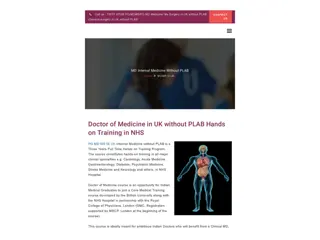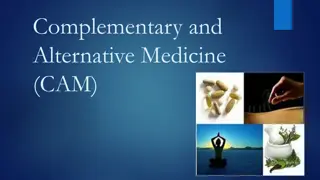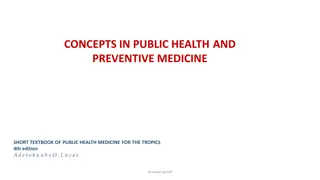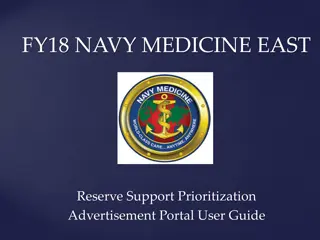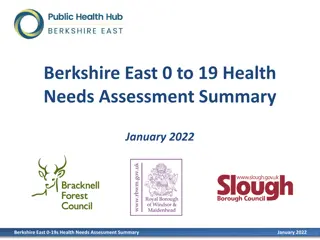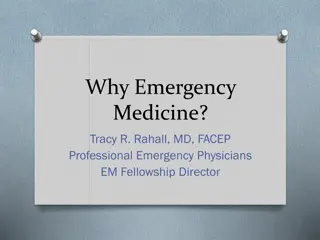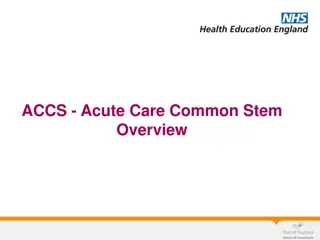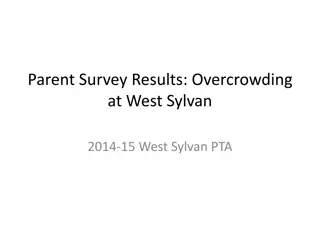
Patient-Reported Outcomes in Health Care Settings
Discover the significance of patient-reported outcomes in health care delivery, exploring topics like effective care, health outcomes measures, patient satisfaction, and health-related quality of life. Gain insights into how individuals' feedback and experiences shape the quality of care they receive.
Download Presentation

Please find below an Image/Link to download the presentation.
The content on the website is provided AS IS for your information and personal use only. It may not be sold, licensed, or shared on other websites without obtaining consent from the author. If you encounter any issues during the download, it is possible that the publisher has removed the file from their server.
You are allowed to download the files provided on this website for personal or commercial use, subject to the condition that they are used lawfully. All files are the property of their respective owners.
The content on the website is provided AS IS for your information and personal use only. It may not be sold, licensed, or shared on other websites without obtaining consent from the author.
E N D
Presentation Transcript
Patient-Reported Outcomes of Health Care Presentation to Visiting Scholars from China Academy of Chinese Medical Sciences April 16, 2014 9:00am 11:00am UCLA Center for East-West Medicine 1033 Gayley Ave, Suite 111 Los Angeles, CA 90024 Ron D.Hays, Ph.D. drhays@ucla.edu 1
U.S. Health Care Issues ACE Signs Access to care ~ 50 million people without health insurance Costs of care Expenditures ~ $ 2.7 Trillion Effectiveness (quality) of care 2
How Do We Know If Care Is Effective? Effective care maximizes probability of desired health outcomes Health outcome measures indicate whether care is effective Cost Effectiveness 3
Health Outcomes Measures Traditional clinical endpoints Survival Clinical/biological indicators Rheumatoid factor Blood pressure Hematocrit Patient-Reported Outcomes 4
Patient-Reported Measures (PRMs) Mediators Health behaviors (adherence) Health Care Process Reports about care (e.g., communication) Outcomes (PROs) Patient satisfaction with care Health-Related Quality of Life (HRQOL) 5
Satisfaction With Care Patient Characteristics Health Behaviors (Adherence) Quality of Care HRQOL Patient Reports About Care Technical Quality 6
Health-Related Quality of Life (HRQOL) How the person FEELs (well-being) Emotional well-being Pain Energy What the person can DO (functioning) Self-care Role Social 7
HRQOL is Not Quality of environment Type of housing Level of income Social Support 8
Types of HRQOL Measures - Targeted vs. Generic - Profile vs. Preference-based 9
Targeted Item During the last 4 weeks, how often were you angry about your irritable bowel syndrome? None of the time A little of the time Some of the time Most of the time All of the time 10
Targeted Multi-Item Scale Burden of Kidney Disease My kidney disease interferes too much with my life. Too much of my time is spent dealing with my kidney disease. I feel frustrated with my kidney disease. I feel like a burden on my family. 11
Generic Item In general, how would you rate your health? Excellent Very Good Good Fair Poor 12
Does your health now limit you in walking more than a mile? (If so, how much?) Yes, limited a lot Yes, limited a little No, not limited at all 13
How much of the time during the past 4 weeks have you been happy? None of the time A little of the time Some of the time Most of the time All of the time 14
Generic Scales (SF-36) Physical functioning (10 items) Role limitations/physical (4 items) Emotional well-being (5 items) Role limitations/emotional (3 items) Social functioning (2 items) Pain (2 items) Energy/fatigue (4 items) General health perceptions (5 items) 15
Scoring HRQOL Scales Average or sum all items in the same scale. Transform average or sum to 0 (worse) to 100 (best) possible range z-score (mean = 0, SD = 1) T-score (mean = 50, SD = 10) 16
Linear Transformations (original score - minimum) *100 (maximum - minimum) X = Y = target mean + (target SD * Zx) (X - X) ZX= SDX 17
Example of Computing z-score and T-score z-score = (score mean)/SD T-score = (10 * z-score) + 50 z-score = (100- 36)/31 = 2.06 T-score = 71 18
HRQOL in HIV Compared to other Chronic Illnesses and General Population Emot. Phy func MS ESRD Diabetes Depression Prostate disease GERD Epilepsy General Pop AIDS Symptomatic Asymptomatic 0 10 20 30 40 50 60 T-score metric 19 Hays et al. (2000), American Journal of Medicine
Physical Health Physical Health Role function physical General Health Physical function Pain 20
Mental Health Mental Health Role function- emotional Social function Emotional Well-Being Energy 21
SF-36 PCS and MCS PCS_z = (PF_Z * 0.42) + (RP_Z * 0.35) + (BP_Z * 0.32) + (GH_Z * 0.25) + (EF_Z * 0.03) + (SF_Z * -.01) + (RE_Z * -.19) + (EW_Z * -.22) MCS_z = (PF_Z * -.23) + (RP_Z * -.12) + (BP_Z * -.10) + (GH_Z * -.02) + (EF_Z * 0.24) + (SF_Z * 0.27) + (RE_Z * 0.43) + (EW_Z * 0.49) PCS = (PCS_z*10) + 50 MCS = (MCS_z*10) + 50 22
Is CAM Better than Standard Care (SC)? 100 90 80 CAM 70 SC 60 CAM 50 SC 40 30 20 10 0 Physical Health Mental Health CAM > SC SC > CAM 23
Is Acupuncture Related to Worse HRQOL? Subject Acupuncture HRQOL (0-100) 1 2 3 4 5 6 7 8 9 No No No No No Yes Yes Yes Yes Yes dead dead 10 50 75 100 0 25 50 75 100 Group n HRQOL No Acupuncture Yes Acupuncture 3 5 75 50 24
Ultimate Use of HRQOL Measures-- Helping to Ensure Access to Cost-Effective Care Cost Effectiveness ( Utility ) 26
QALYs: The Basics Milton Weinstein, George Torrance, Alistair McGuire (Value in Health, 2009, vol. 12 Supplement 1) What is value? Preference or desirability of health states How are QALYs used? Societal resource allocation Personal decisions such as decision about whether to have a treatment Societal or program audit Evaluate programs in terms of health of the population. 28
http://araw.mede.uic.edu/cgi- bin/utility.cgi http://araw.mede.uic.edu/cgi-bin/utility.cgi 29
SG>TTO>RS SG = TTOa SG = RSb Where a and b are less than 1 30
SF-6D health state (424421) = 0.59 Your health limits you a lot in moderate activities (such as moving a table, pushing a vacuum cleaner, bowling or playing golf) You are limited in the kind of work or other activities as a result of your physical health Your health limits your social activities (like visiting friends, relatives etc.) most of the time. You have pain that interferes with your normal work (both outside the home and housework) moderately You feel tense or downhearted and low a little of the time. You have a lot of energy all of the time 31
Reliability Minimum Standards 0.70 or above (for group comparisons) 0.90 or higher (for individual assessment) SEM = SD (1- reliability)1/2 95% CI = true score +/- 1.96 x SEM if true z-score = 0, then CI: -.62 to +.62 Width of CI is 1.24 z-score units 32
Range of reliability estimates 0.80-0.90 for blood pressure 0.70-0.90 for multi-item self-report scales Hahn, E. A., Cella, D., et al. (2007). Precision of health-related quality-of-life data compared with other clinical measures. Mayo Clin Proceedings, 82 (10), 1244-1254. 33
Self-Reports of Physical Health Predict Five-Year Mortality 17 18 16 14 % 12 10 Dead 8 6 5 6 4 2 2 0 (n=676) (n=754) (n=1181) (n=609) <35 35-44 45-54 >55 SF-36 Physical Health Component Score (PCS) T score Ware et al. (1994). SF-36 Physical and Mental Health Summary Scales: A User s Manual. 34
Mortality Prediction with a Single General Self-Rated Health Question DeSalvo, K. B., Bloser, N., Reynolds, K., He, J., & Muntner, P. (2005). Mortality prediction with a single general self-rated health question: A meta- analysis. JGIM, 20, 267-275. 35
Course of Emotional Well-being Over 2-years for Patients in the MOS General Medical Sector 81 Hypertension 79 77 Diabetes 75 73 71 0-100 range 69 67 65 Major Depression 63 61 59 57 55 2-Years Baseline Hays, R.D., Wells, K.B., Sherbourne, C.D., Rogers, W., & Spritzer, K. (1995). Functioning and well-being outcomes of patients with depression compared to chronic medical illnesses. Archives of General Psychiatry, 52, 11-19. 36
Physical Functioning in Relation to Time Spent Exercising 2-years Before 84 Hypertension 82 80 Diabetes 78 76 0-100 range 74 Current Depression 72 70 68 66 64 62 Low High Total Time Spent Exercising Stewart, A.L., Hays, R.D., Wells, K.B., Rogers, W.H., Spritzer, K.L., & Greenfield, S. (1994). Long-term functioning and well-being outcomes associated with physical activity and exercise in patients with chronic conditions in the Medical Outcomes Study. Journal of Clinical Epidemiology, 47, 719-730. 37
HRQOL in SEER-Medicare Health Outcomes Study (n = 126,366) Controlling for age, gender, race/ethnicity, education, income, and marital status. 38
Distant stage of cancer associated with 0.05-0.10 lower SF-6D Score 0.8 0.78 0.76 0.74 Local-Region 0.72 Distant 0.7 Unstaged 0.68 0.66 0.64 Breast Pros. Col. Lung Figure 1. Distant Stage of Disease Associated with Worse SF-6D Scores (Sample sizes for local/regional, distant, and unstaged: Breast (2045,26, 347); Prostate (2652, 61 and 633), Colorectal (1481, 48 and 203), and Lung (466, 47 and 65). 39
Physical Functioning and Emotional Well-Being at Baseline for 54 Patients at UCLA-Center for East West Medicine EWB Physical MS = multiple sclerois; ESRD = end-stage renal disease; GERD = gastroesophageal reflux disease. 40 40
Significant Improvement in all but 1 of SF-36 Scales (Change is in T-score metric) Change t-test prob. PF-10 RP-4 BP-2 GH-5 EN-4 SF-2 RE-3 EWB-5 PCS MCS 1.7 4.1 3.6 2.4 5.1 4.7 1.5 4.3 2.8 3.9 2.38 3.81 2.59 2.86 4.33 3.51 0.96 3.20 3.23 2.82 .0208 .0004 .0125 .0061 .0001 .0009 .3400 .0023 .0021 .0067 41
Effect Size (Follow-up Baseline)/ SDbaseline Cohen s Rule of Thumb: ES = 0.20 Small ES = 0.50 Medium ES = 0.80 Large 42
Effect Sizes for Changes in SF-36 Scores Effect Size 50 0.53 0.36 0.13 0.35 0.35 0.21 0.11 0.41 0.24 0.30 45 40 35 30 25 Baseline 20 Followup 15 10 5 0 PFI Role-P Pain Gen H Energy Social Role-E EWB PCS MCS PFI = Physical Functioning; Role-P = Role-Physical; Pain = Bodily Pain; Gen H=General Health; Energy = Energy/Fatigue; Social = Social Functioning; Role-E = Role-Emotional; EWB = Emotional Well-being; PCS = Physical Component Summary; MCS =Mental Component Summary. 43
Defining a Responder: Reliable Change Index (RCI) X X 2 1 ( 2 ( ) ) SEM = 1 SEM SD r bl xx Note: SDbl= standard deviation at baseline rxx = reliability 44
Amount of Change in Observed Score Needed To be Statistically Significant ( 2 (SD ) ) r - (1 (1.96) ) xx bl Note: SDbl= standard deviation at baseline and rxx = reliability 45
Amount of Change Needed for Significant Individual Change Effect Size 1.33 1.07 0.67 0.72 1.01 1.13 0.71 1.26 0.62 0.73 PFI = Physical Functioning; Role-P = Role-Physical; Pain = Bodily Pain; Gen H=General Health; Energy = Energy/Fatigue; Social = Social Functioning; Role-E = Role-Emotional; EWB = Emotional Well-being; PCS = Physical Component Summary; MCS =Mental Component Summary. 46
7-31% of People in Sample Improve Significantly % Improving % Declining Difference PF-10 RP-4 BP-2 GH-5 EN-4 SF-2 RE-3 EWB-5 PCS MCS 13% 31% 22% 7% 9% 17% 15% 19% 24% 22% 2% 2% 7% 0% 2% 4% 15% 4% 7% 11% + 11% + 29% + 15% + 7% + 7% + 13% 0% + 15% + 17% + 11% 47
Item Responses and Trait Levels Person 1 Person 2 Person 3 Trait Continuum Item 1 Item 2 Item 3 www.nihpromis.org 48
Reliability Target for Use of Measures with Individuals Reliability ranges from 0-1 0.90 or above is goal SEM = SD (1- reliability)1/2 95% CI = true score +/- 1.96 x SEM if true z-score = 0, then CI: -.62 to +.62 Width of CI is 1.24 z-score units Reliability = 0.90 when SE = 3.2 T-scores (mean = 50, SD = 10) Reliability = 1 (SE/10)2 T =50 + (z * 10) 50


